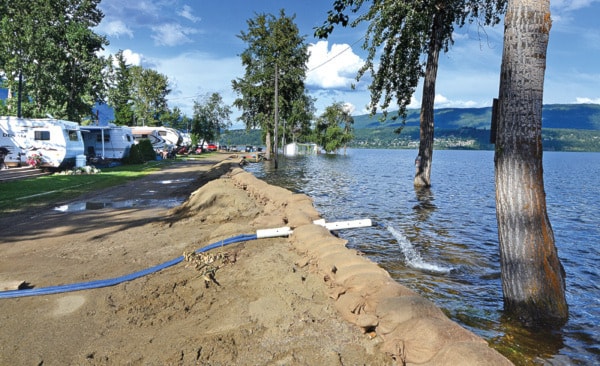While a flood watch is still in place in the Shuswap, officials believe it will be all down river from here.
David Campbell of the BC River Forecast Centre said yesterday that while rain in the forecast could contribute to a slight rise in Shuswap River, dry sunny weather predicted for the next several days would see water levels dropping again.
The same could be said for Shuswap Lake, which also remains on flood watch and will do so until the water level drops by another 15 to 20 centimetres, something Campbell believes will happen on the weekend, or early next week.
And while higher temperatures will speed up the melt of higher elevation snowpacks, Campbell says they are now about 40 per cent of what they were before and not expected to cause a problem.
He says rapid snow melt becomes an issue when both high-elevation and mid-elevation snowpacks are melting at the same time.
John Rosenberg, public works manager for the City of Salmon Arm, says he figures the lake dropped about four inches over the weekend.
He says staff have already begun the long, slow process of cleaning up the debris the water leaves behind. Canoe Beach is littered with debris, brought into shore by the same wave action that took normally out-of reach items out into the lake in the first place.
“I think a lot of stuff was sitting on shore a metre or metre-and-a-half higher than normal water levels.”
One victim of wave action was the large, carved salmon that sat on the breakwater in Salmon Arm Bay. It was knocked off its perch.
“It was in Monday’s photos and was found floating near the marina Tuesday morning,” Rosenberg says, noting the salmon is at public works where it will be assessed and repaired or revarnished as necessary. As well, efforts are being made to locate the carver.
Other than the salmon, Rosenberg says Salmon Arm has done relatively well in terms of damage – at least what has been revealed so far.
“We virtually went unscathed, other than the federal wharf in Canoe,” he says. “It’s definitely lifted from its pilings but we’re hoping it will settle back down. It looks like a mini rollercoaster.”
What remains hidden underwater is the state of the shoreline and the grass at Canoe Beach, which has been underwater for a couple of weeks. The beach remains closed to the public, as does the federal wharf.
Dan Ferguson, assistant director health protection for Interior Health, says in terms of public safety, there are two important pieces of information.
The first is that no one should be drinking untreated surface water at any time of the year – anywhere in B.C.
“There are any number of pathogens in the water,” he says emphatically. “If it’s untreated water from a creek, river or lake, don’t drink it – ever.”
The second piece of information Ferguson would like residents to know is that flooding brings an increased risk to water supply and those who own a private well that has been comprised should disinfect it. Instructions for doing so are available at www.interiorhealth.ca.
With respect to community or private water systems, residents should call their purveyors to ask about the potability of their water.
“Particularly in Mara Lake, there is increased turbidity following the two flash floods,” says Ferguson of the level of particulate in the water. “It’s not the turbidity, it’s what the sediment is concealing or bringing with it.”
Ferguson says two well-known culprits are crypto sporidium and giardia, both parasites that are destroyed by boiling water.
“If we were to sample any surface water body in B.C., we would not be surprised to find two indicator organisms in the water at any time – total coliform and E. coli,” he adds. “Typically with flood events, we have increased potential for E.coli due to potential flooding of agriculture, septic fields and whatever’s running from the roads – moose or dog feces. Whatever is out there is now in the water.”
The same precautions apply – don’t drink without boiling.
“The last message is yes, you can expect total coliform and E.coli in water, but the bigger hazard is the large amount of debris on surface and subsurface of the lakes,” he says, noting swimmers just need to avoid swallowing the water to avoid problems with E.coli. “Try to make sure you’re swimming in an area that doesn’t have debris.”
Editor's note: Water quality in Mara Lake was compromised with spillage of sewage and chemicals, including fuel, near Sicamous' Mara water intake. Subsequently, Sicamous is under a Do Not Consume order. Boiling water will not make the water safe to ingest. Sicamous' Two Mile subdivision is under a Boil Water advisory.
